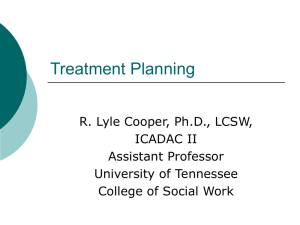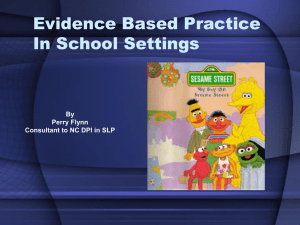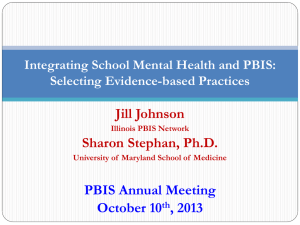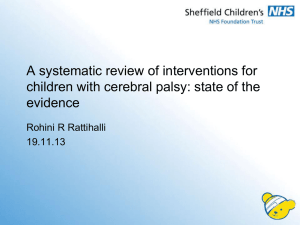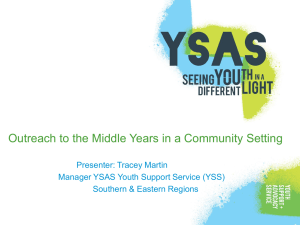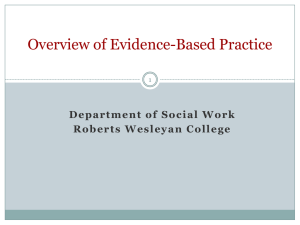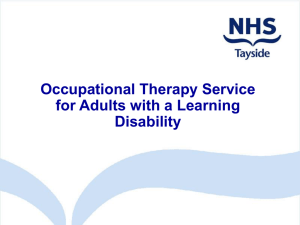Evidence Based Practices: What Works With Juveniles
advertisement
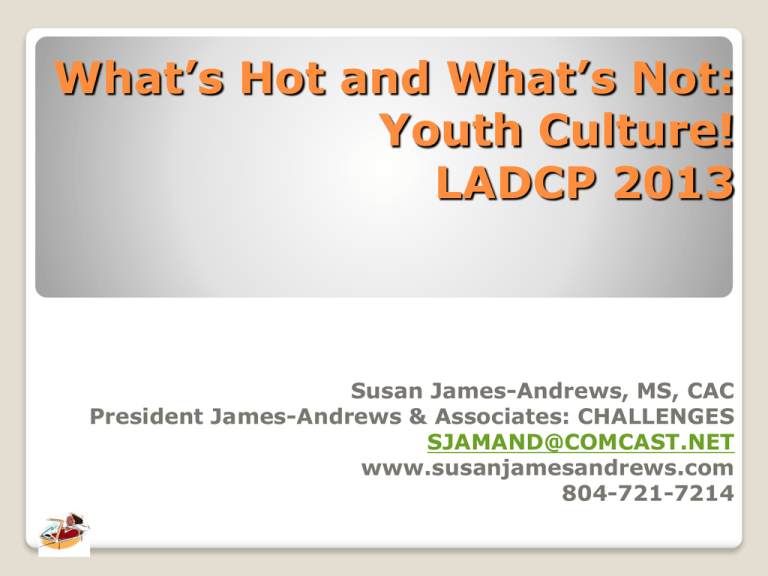
What’s Hot and What’s Not: Youth Culture! LADCP 2013 Susan James-Andrews, MS, CAC President James-Andrews & Associates: CHALLENGES SJAMAND@COMCAST.NET www.susanjamesandrews.com 804-721-7214 Explore the use of non-traditional youth service delivery systems to partner with in Drug Courts Define youth culture Learn what not to say when working with youth Revisit the 16 strategies Learning Objectives 2 What’s Hot What’s Not What’s Hot and What’s Not? 3 Evidence Based Practices Evidence Based Practices (EBP) are treatment, interventions and practices with consistent, scientific evidence showing that there is improvement in client outcomes James-Andrews & Associates: CHALLENGES 2012 4 What early studies taught us Adult models and/or mixed with adults does not work Need to modify Need to address Need to modify ? What works for juvenile justice interventions Target high risk offenders Longer duration of treatment > 90 days Treatment is evidence -based Treatment involves the family Use of rewards to shape behavior Compliance is addressed with immediate responses 6 ?? Lil Wayne Taylor Swift 7 ?? Rick Ross Nicki Minaj 8 WHAT ARE SOME of THE Not So NEW DRUGS & other Stuff Creativity 9 ?? Cinnamon Challenge Twitter mentions peaking at 70,000 per day 10 Bath Salts Ivory Wave," "Purple Wave," Vanilla Sky," and "Bliss" – . Not like Epsom salt marketed as “bath salt” – not for human consumption 11 Prom? A new way of dating? 12 ?? Prom – Celebrity cutouts as dates Justin Bieber Tim Tebow 13 More about Treatment Who comes up with this stuff? 14 How do we decide what EBP’s would work best for our youth? … 15 EBP ◦ Good outcomes ◦ Can be replicated ◦ Staff are trained in the use of the model ◦ Supervision leads to certification ◦ Monitoring ◦ Outcomes measurement LESSONS LEARNED 16 What’s Hot and What’s NOT? 17 ACRA ASPRA BTT Five steps to success for youth CBT MAT PYT MET BST Seeking safety 7C MST FSTD MRT MAT MI MSFT FFT HOT OR NOT? 18 What Works There are a variety of models that work Quality matters 19 ?? 12 Key Elements of Effective Treatment 20 1 2 3 4 5 6 7 8 Screening Comprehensive Assessment – ex. GAIN- Global Gender responsive Culturally competent Comprehensive integrated treatment approach Continuing care Individualized What else? Key Elements 21 Promptness Developmentally appropriate tools Engagement and inclusivity Periodic Screen and Assess 22 Three Broad Categories I. MET/MI II. Family Based Interventions III. Behavioral or Psychosocial Interventions Integrating Approaches for Adolescents 23 Other Common Findings Low structure and ad hoc “treatment as usual” does not do as well as evidenced based practice Relapse is still common Impact of quality assurance Effects associated with Coaching, Certification and Monitoring (OR=7.6) Source: CSAT 2008 SA Dataset subset to 6 Month Follow up (n=1,961) 25 Overview of study results All programs reduced mental health / trauma problems Programs with more training, quality assurance, Seven Challenges, While it is not the most effective 26 Retention enhanced “safe” Has rapport Empowered 27 ?? NIATx Promising Practices What treatment providers can do to improve operations and outcomes 28 Reduce Reduce Reduce Increase continuation (retention) Increase admissions www.NIATx.com 29 The Environment Matters Build rapport through ◦ ◦ ◦ ◦ ◦ ◦ Information sharing Trust Incentives Affirmation and recognition Focus on the person Place the responsibility back on the youth ?? 30 Review of the Strategies ?? 16 Strategies 31 Journey Continues Areas to Consider Cost Capabilities Training Fidelity 32 Questions? Susan James-Andrews, MS,CAC James-Andrews & Associates: CHALLENGES sjamand@comcast.net www.susanjamesandrews.com 804-721-7214 33
